The Intel Haswell Refresh Review: Core i7-4790, i5-4690 and i3-4360 Tested
by Ian Cutress on May 11, 2014 3:01 AM ESTReal World Benchmarks
2D to 3D Rendering –Agisoft PhotoScan v1.0: link
Agisoft Photoscan creates 3D models from 2D images, a process which is very computationally expensive. The algorithm is split into four distinct phases, and different phases of the model reconstruction require either fast memory, fast IPC, more cores, or even OpenCL compute devices to hand. Agisoft supplied us with a special version of the software to script the process, where we take 50 images of a stately home and convert it into a medium quality model. This benchmark typically takes around 15-20 minutes on a high end PC on the CPU alone, with GPUs reducing the time.
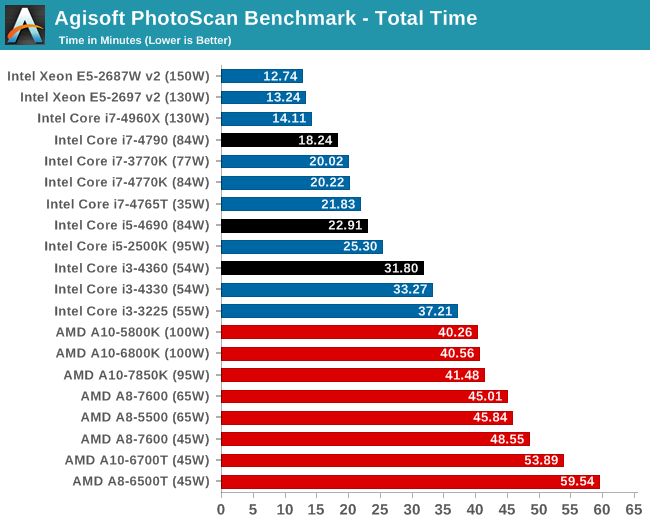
For Photoscan we see the incremental speedup with the i3 models, but the increased single thread speed of the i7 makes more of a difference.
Compression – WinRAR 5.0.1: link
Our WinRAR test from 2013 is updated to the latest version of WinRAR at the start of 2014. We compress a set of 2867 files across 320 folders totaling 1.52 GB in size – 95% of these files are small typical website files, and the rest (90% of the size) are small 30 second 720p videos.
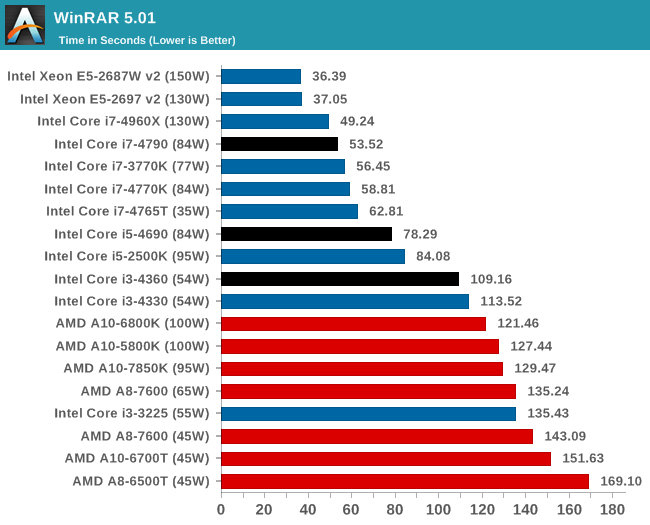
For WinRAR, the increase in the threads makes the most difference here, moving from i5-4690 to i7-4675T.
Image Manipulation – FastStone Image Viewer 4.9: link
Similarly to WinRAR, the FastStone test us updated for 2014 to the latest version. FastStone is the program I use to perform quick or bulk actions on images, such as resizing, adjusting for color and cropping. In our test we take a series of 170 images in various sizes and formats and convert them all into 640x480 .gif files, maintaining the aspect ratio. FastStone does not use multithreading for this test, and thus single threaded performance is often the winner.
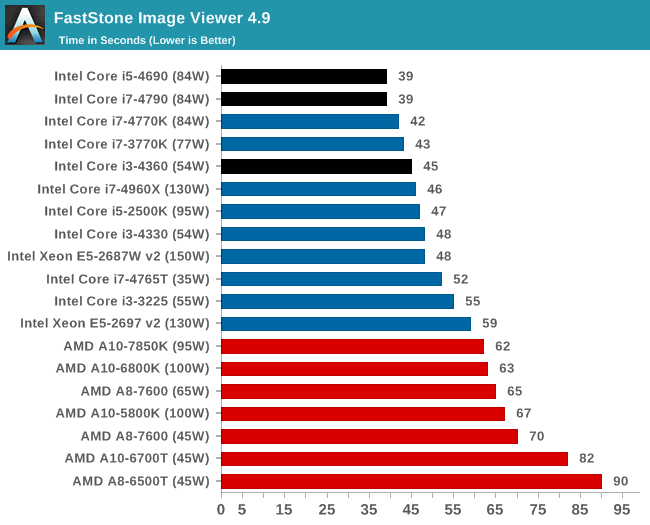
FastStone is all about the single thread speed.
Video Conversion – Xilisoft Video Converter 7: link
The XVC test I normally do is updated to the full version of the software, and this time a different test as well. Here we take two different videos: a double UHD (3840x4320) clip of 10 minutes and a 640x266 DVD rip of a 2h20 film and convert both to iPod suitable formats. The reasoning here is simple – when frames are small enough to fit into memory, the algorithm has more chance to apply work between threads and process the video quicker. Results shown are in seconds and time taken to encode.
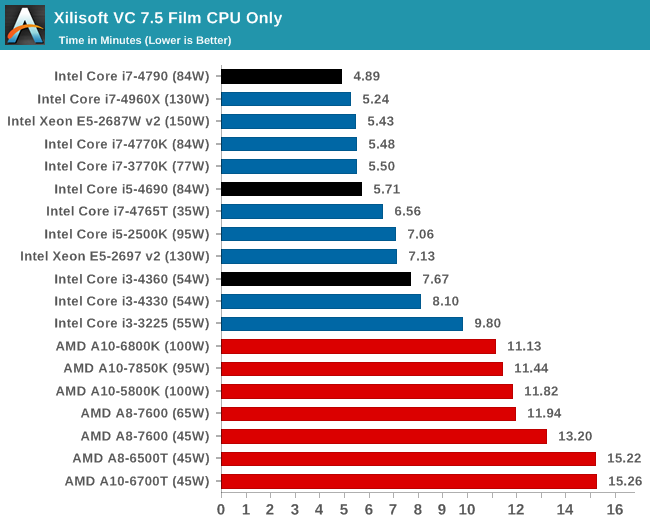
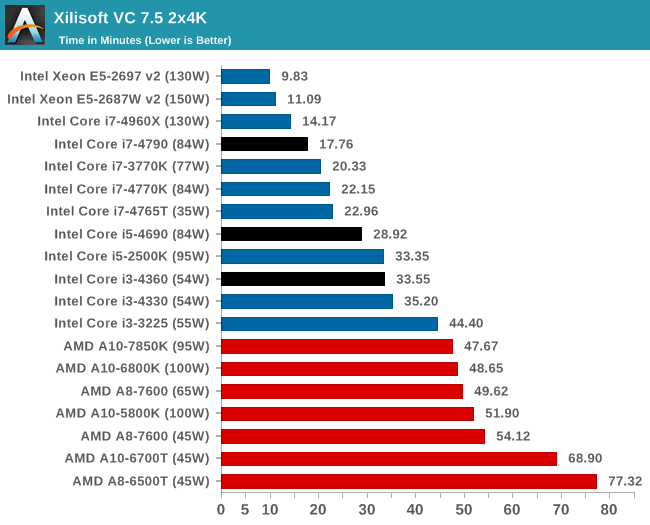
Small frames prefer more single thread MHz, whereas the dual 4K frame conversion prefers threads.
Video Conversion – Handbrake v0.9.9: link
Handbrake is a media conversion tool that was initially designed to help DVD ISOs and Video CDs into more common video formats. The principle today is still the same, primarily as an output for H.264 + AAC/MP3 audio within an MKV container. In our test we use the same videos as in the Xilisoft test, and results are given in frames per second.
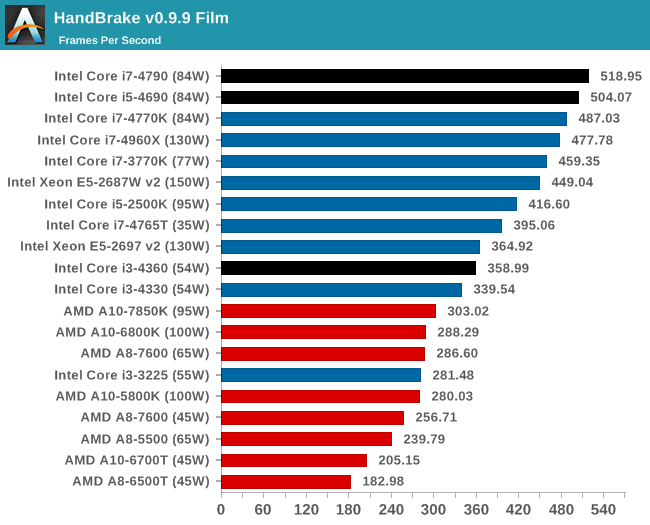
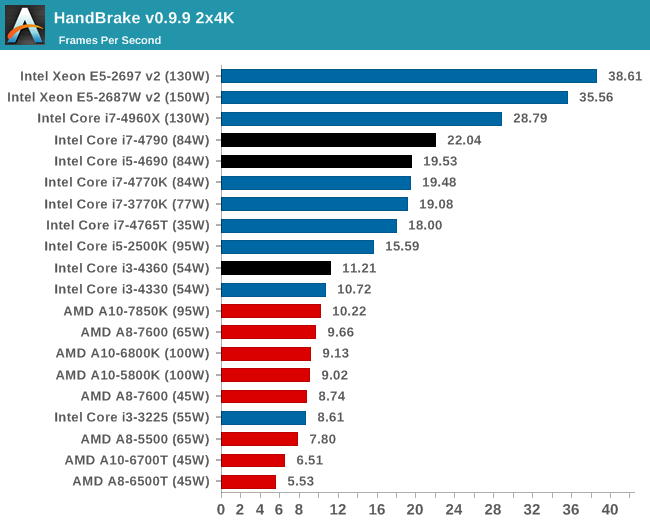
With Handbrake it would seem that it prefers actual cores rather than hyperthreading, given by the i5 and i7 being relatively close and 2x the i3.










130 Comments
View All Comments
willis936 - Sunday, May 11, 2014 - link
Man why are you reading anantech if you think redundant data collection is a waste of time? Verification of both results and of expectations in new products is valuable. Intel could call it a refresh after botching every wafer in the past six months and dump it into a new product line.DanNeely - Sunday, May 11, 2014 - link
This is the locked, non OC, portion of the Haswell refresh. The new unlocked chips have a rumored ETA of early next month.If you're not interested; go read something else instead. What you want isn't available yet.
Flunk - Monday, May 12, 2014 - link
Proving there is no credible difference is useful, maybe it will save some people a few bucks.nutjob2 - Sunday, May 11, 2014 - link
Intel is chasing a dying market, ie, those who are willing to pay for single threaded performance at any cost, and worry less about power consumption, in the desktop and server space.These people fall into two broad categories:
First there are gamers with more money than sense who spend hundreds or thousands each year on the latest CPU/motherboard/GPU that delivers a 5%-10% increase in framerate. Also other people who feel they need the latest and greatest for whatever reason.
On these people Intel dumps their hottest parts since they're not very concerned about power consumption, water cooling is a badge of honor for these guys.
Then there are the corporates who are visited by HP/Dell/etc salesmen and are told they need big, big iron so they can virtualise all their servers to "save money". That of course means they've created a single point of failure for all those servers so they need a machine with redundant everything and huge density. No-one has the heart to tell them they still have a single point of failure.
These people don't so much care about power consumption than the fact you can't cool or deliver power very well to multiple processors in a box, so Intel give them their somewhat cooler parts. Because most of the software they run is not very clever and largely single threaded they stick to Intel.
The smart corporate money is not buying any of Intel's overpriced CPUs instead they're sticking with their existing hardware and waiting for "cloud" providers to lower their prices. Why are they doing that? Because Intel is playing most of the above market for suckers, making them pay through the nose while they sell their best parts to Amazon, Google, Microsoft, IBM et all who pay a fraction of what everyone pays. Intel doesn't do this out of the kindness of their hearts but because they know that cloud providers will eventually replace many of their existing direct customers and because they don't care about single threaded performance (they're almost always using all their cores). Intel are milking their cash cows while they kiss up to the new big players, lest they start getting too friendly with AMD or ARM vendors who can make custom parts for them, just like the big players make their own motherboards, etc shutting out people like HP and Dell.
willis936 - Sunday, May 11, 2014 - link
Adding an extra 20 to product numbers is "chasing"?betam4x - Sunday, May 11, 2014 - link
Regarding your comments:1) Gamers don't spend 'hundreds of thousands of dollars every year' on PC components. Top of the line PC hardware can be had for under 3 grand. Typically the users who buy this years new hardware are the ones that skipped the past 1-2 generations of hardware.
2) Intel's parts aren't 'hot'. They are more power efficient than they've ever been. The performance per watt is among the highest in the industry.
3) Virtualizing does save money. Even if that server went up in flames, a backup of that VM is stored elsewhere so that it can be quickly brought back up on the backup server located in another rack. This means minutes of downtime instead of hours.
4) At my company we buy intel CPUs every day. We upgrade all of our machines every 3 years and often have to buy new machines for new employees. Of course, we do other 'crazy' things as well, like dual monitors, ample workspace, etc. Imagine that?
Gigaplex - Monday, May 12, 2014 - link
"Gamers don't spend 'hundreds of thousands of dollars every year' on PC components."They said hundreds OR thousands, not "of".
rajod1 - Friday, May 30, 2014 - link
Gamers as a group spend millions on upgrades not hundreds or thousands.maximumGPU - Tuesday, May 13, 2014 - link
Upgrade every 3 years, and new machines for new employees? I'd like to apply to a job in your company, tired of XP and pentium 4's in my current one.YuLeven - Wednesday, May 14, 2014 - link
Know that feel. I use a Celeron D here.